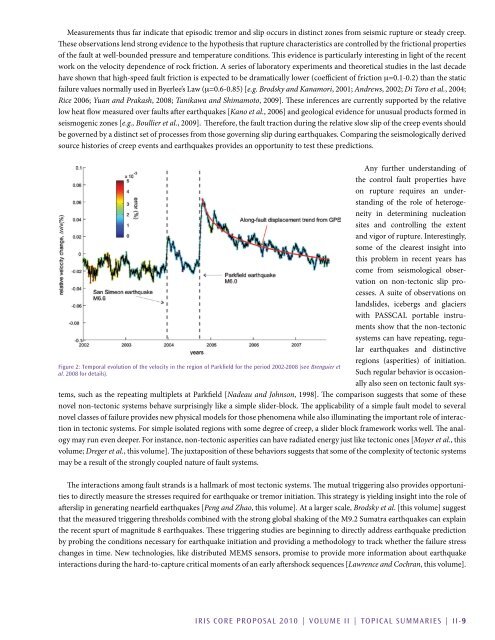Accomplishments - IRIS
Accomplishments - IRIS
Accomplishments - IRIS
You also want an ePaper? Increase the reach of your titles
YUMPU automatically turns print PDFs into web optimized ePapers that Google loves.
Measurements thus far indicate that episodic tremor and slip occurs in distinct zones from seismic rupture or steady creep.<br />
These observations lend strong evidence to the hypothesis that rupture characteristics are controlled by the frictional properties<br />
of the fault at well-bounded pressure and temperature conditions. This evidence is particularly interesting in light of the recent<br />
work on the velocity dependence of rock friction. A series of laboratory experiments and theoretical studies in the last decade<br />
have shown that high-speed fault friction is expected to be dramatically lower (coefficient of friction μ=0.1-0.2) than the static<br />
failure values normally used in Byerlee’s Law (μ=0.6-0.85) [e.g. Brodsky and Kanamori, 2001; Andrews, 2002; Di Toro et al., 2004;<br />
Rice 2006; Yuan and Prakash, 2008; Tanikawa and Shimamoto, 2009]. These inferences are currently supported by the relative<br />
low heat flow measured over faults after earthquakes [Kano et al., 2006] and geological evidence for unusual products formed in<br />
seismogenic zones [e.g., Boullier et al., 2009]. Therefore, the fault traction during the relative slow slip of the creep events should<br />
be governed by a distinct set of processes from those governing slip during earthquakes. Comparing the seismologically derived<br />
source histories of creep events and earthquakes provides an opportunity to test these predictions.<br />
Figure 2: Temporal evolution of the velocity in the region of Parkfield for the period 2002-2008 (see Brenguier et<br />
al. 2008 for details).<br />
Any further understanding of<br />
the control fault properties have<br />
on rupture requires an understanding<br />
of the role of heterogeneity<br />
in determining nucleation<br />
sites and controlling the extent<br />
and vigor of rupture. Interestingly,<br />
some of the clearest insight into<br />
this problem in recent years has<br />
come from seismological observation<br />
on non-tectonic slip processes.<br />
A suite of observations on<br />
landslides, icebergs and glaciers<br />
with PASSCAL portable instruments<br />
show that the non-tectonic<br />
systems can have repeating, regular<br />
earthquakes and distinctive<br />
regions (asperities) of initiation.<br />
Such regular behavior is occasionally<br />
also seen on tectonic fault systems,<br />
such as the repeating multiplets at Parkfield [Nadeau and Johnson, 1998]. The comparison suggests that some of these<br />
novel non-tectonic systems behave surprisingly like a simple slider-block. The applicability of a simple fault model to several<br />
novel classes of failure provides new physical models for those phenomena while also illuminating the important role of interaction<br />
in tectonic systems. For simple isolated regions with some degree of creep, a slider block framework works well. The analogy<br />
may run even deeper. For instance, non-tectonic asperities can have radiated energy just like tectonic ones [Moyer et al., this<br />
volume; Dreger et al., this volume]. The juxtaposition of these behaviors suggests that some of the complexity of tectonic systems<br />
may be a result of the strongly coupled nature of fault systems.<br />
The interactions among fault strands is a hallmark of most tectonic systems. The mutual triggering also provides opportunities<br />
to directly measure the stresses required for earthquake or tremor initiation. This strategy is yielding insight into the role of<br />
afterslip in generating nearfield earthquakes [Peng and Zhao, this volume]. At a larger scale, Brodsky et al. [this volume] suggest<br />
that the measured triggering thresholds combined with the strong global shaking of the M9.2 Sumatra earthquakes can explain<br />
the recent spurt of magnitude 8 earthquakes. These triggering studies are beginning to directly address earthquake prediction<br />
by probing the conditions necessary for earthquake initiation and providing a methodology to track whether the failure stress<br />
changes in time. New technologies, like distributed MEMS sensors, promise to provide more information about earthquake<br />
interactions during the hard-to-capture critical moments of an early aftershock sequences [Lawrence and Cochran, this volume].<br />
<strong>IRIS</strong> Core Proposal 2010 | Volume II | Topical Summaries | II-9

















